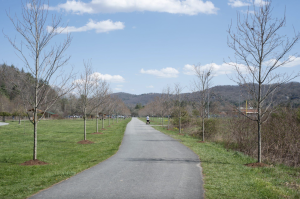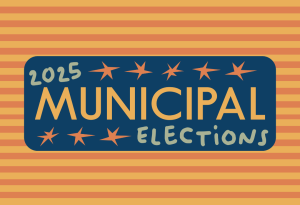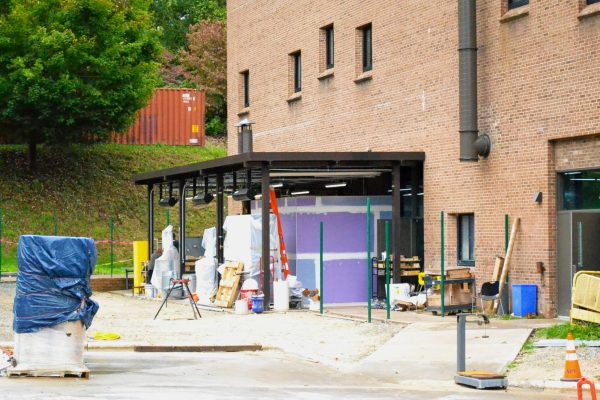Boone announces 100% renewable energy for municipal operations
January 25, 2022
The Town of Boone’s buildings and vehicles will be powered by 100% renewable energy by February, eight years ahead of its 2030 goal.
The Boone Town Council voted during the Jan. 12 town council meeting to allot $60,290 for the municipal operation project. The funding would make Boone the first municipality in North Carolina to achieve 100% renewable energy, according to a Jan. 14 Town of Boone press release.
“Congratulations to the Town of Boone on this outstanding milestone. This is a great example of North Carolinians working toward a clean energy future,” Governor Roy Cooper tweeted, Jan. 20.
BTC achieves its February goal by purchasing solar energy from Blue Ridge Energy and hydroelectric energy from New River Light and Power, according to the release.
According to sustainability and special projects manager, George Santucci, BRE’s solar-generated energy will make up approximately 75% of Boone’s municipal electricity with up to 4,800 megawatt-hours from their new 11 MWh solar array.
Blue Ridge Energy’s new solar array is projected to produce more than 19 million kilowatts of clean energy per year. It is BRE’s largest renewable energy project yet, according to Renee Whitener, BRE’s director of public relations.
“Carbon neutrality isn’t necessarily as beneficial or progressive as advertised… If we actually want to address climate change, we need to be thinking on a national scale,” said Hannah Cullen, App State alumna and ClimACT member.
The Green Power Program, a partnership between the university and NRLP, will provide approximately 1,600 megawatt-hours of hydroelectric power, making up about 25% of Boone’s municipal electric consumption, said Santucci.
“Boone cannot meet its goal of municipal climate neutrality by 2030 and to transition the entire town to 100% clean and renewable energy by 2050 without New River Light and Power and Blue Ridge Energy stepping up and sourcing renewable energy for Boone. We are grateful for their successful efforts,” Santucci wrote in a press release, Jan. 14.
In January 2021, the Boone Town Council created a five-step approach to eliminate carbon emissions and for municipal operations to be net neutral by 2030.
In 2019, the Town of Boone established a three-part timeline to increase sustainability. The first, being to reach climate neutrality with net-zero greenhouse gas emissions in municipal operations by 2030. The second, to transition municipal operations to 100% clean renewable energy by 2040. The third goal is for all of Boone, including App State, to be using 100% clean renewable energy by 2050.
“Initially, I was excited to hear about the move to carbon neutrality for Boone’s municipal energy consumption,” Cullen said. “I’m grateful that this is a conversation that is being had in our town. It sends the message that renewables are desirable and that public utilities like NRLP are willing to purchase it.”
Purchasing renewable energy from NRLP and Blue Ridge Energy furthers Boone’s process toward its 2030 goal of climate neutrality for municipal operations, Santucci said.
“This means that all the electricity that Boone uses for municipal operation will come from renewable energy sources,” he said. “With this achieved, we’re moving on to electrifying our fleet of vehicles. We also need to work on converting other operations from fossil fuels like building heat systems to achieve the 2030 goal.”
The Green Power Program allows NRLP customers to purchase blocks of hydroelectric power in $5 increments, representing 250 kilowatt-hours of renewable energy per block. The blocks offset the monthly carbon-based electric use from customers, according to the Green Power Program website.
“If our purchasing of renewable energy limits the availability for others to do so, then it isn’t doing much in terms of the climate. And while NRLP offers its Green Power Program to its customers, the cost falls on the consumer—and in a county with a relatively high poverty rate, the program won’t be very enticing,” Cullen said.
The typical residential customer uses 750 KWh for electricity per month. Therefore, customers can offset 100% of their electric usage with renewable energy for $15 extra per month, according to NRLP.
NRLP entered a contract with the 375 MWh Smoky Mountain portfolio to purchase renewable energy. The Smoky Mountain portfolio consists of four hydropower facilities located along the Little Tennessee and Cheoah rivers in Tennessee and North Carolina.
Santucci said the Town of Boone is essentially paying 2 cents per KWh more for renewable energy than natural gas-generated energy. Santucci also said the price is projected to drop in the future as natural gas prices rise and demand for renewable energy increases.
“Community-owned renewable energy would be a leap in the right direction. It would keep the profits of renewables in our community while still enabling other communities to do the same. There is some real potential and energy here, it would be great to see it taken even further,” Cullen said.

















patrick richardson • Jan 26, 2022 at 7:34 am
“Town of Boone announces 100% renewable energy for municipal operations by February” is misleading.
That is 100% renewable *electricity*. This does not include fossil fuels used for heating, transportation, and other uses.
For example, at Appalachian State 63% of our fixed asset (non-transportation) energy came from on-site burning of fossil fuels in 2019. Since only 37% comes from electricity, even if we were to go to 100% renewable electricity, our present system still use 63% fossil fuels. The amount of electrically operated transportation during the same period was close to 0%, despite great progress towards electrification.
It is important to acknowledge these great strides. However , it is also important to realize the total progress. Appalachian State, while still using this large amount of fossil fuels, has reduced total energy use by 20% between 2006 and 2019 while *increasing* the size of the campus by 21%– a 37% increase in energy efficiency despite adding air conditioning to many buildings.
Mike Hambourger • Jan 26, 2022 at 7:24 am
I recently learned of the ‘Green Power Program’ offered through New River Light & Power. https://nrlp.appstate.edu/greenpower The notion of ‘climate-friendly energy’ is highly appealing. I applaud NRLP’s interest in the topic. However, the current program is not a climate-friendly alternative. Rather it is a farce. It offers increased cost with zero climate benefit. Customers who opt-in may gain the false satisfaction of feeling they are supporting renewable energy. But their contribution will add no new renewable energy to the electric grid, nor will it reduce carbon emissions. The entire renewable portfolio comes from 60+ year old hydroelectric plants. The electricity generated has long been a part of the existing mix. This is a simple shell game. NRLP customers may claim a ‘greener’ source of electricity only by offering everyone else a correspondingly ‘browner’ electricity mix. It is analogous to eating only the red M&Ms out of a bag. The joy of a select M&M mix comes only at the expense of others. Without Mars making a higher proportion of red M&Ms, there is no improvement in the overall candy offering. Without NRLP investing in new alternative energy capacity, there is no climate benefit to the ‘Green Power Program’. To be sure, paying more in the name of ‘Green Power’ signals a willingness to pay more. This may indicate a market primed for investment in low-carbon energy alternatives. But this plan offers no such investment. Please contact NRLP and ask them to offer a climate-friendly product we can believe in.
FYI, Watauga Democrat refused to publish this op-ed in the name of not burning bridges with the university. Surprise!
MuChao • Jan 27, 2022 at 12:18 pm
Well said, Mike! And you’re exactly right on all points. Regarding the university specifically, I’m concerned by the fact that REI is footing 33% of the $150k bill for the newly-purchased old-hydro. REI is there to give students an opportunity to design and implement actual RE solutions *on campus* not just to hand over that student money to the university to pay for something that ought to 100% covered via university funds, not *voluntary* student fees. Obviously this is up to REI to decide, but I personally think it’s a mistake to start handing over REI funds to the university, it’s only going to set a bad precedent.
Putting aside for a moment the fact that this is old-hydro, I think it’s also imperative that folks know that for just 4%(!) of the *annual losses* incurred each and every year by Athletics, the university could purchase 100% of their electricity through this program…
To your last point, considering the incestuous relationship between the University and the WD, I’m not the least bit surprised they refused to publish it. The WD basically just functions as a megaphone for university propaganda. In the rare cases that they do print a story that’s even *slightly* critical of the university, it’s scrubbed from the front page within less than 24 hours…